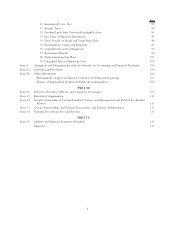Northrop Grumman 2010 Annual Report Download - page 19
Download and view the complete annual report
Please find page 19 of the 2010 Northrop Grumman annual report below. You can navigate through the pages in the report by either clicking on the pages listed below, or by using the keyword search tool below to find specific information within the annual report.We could be affected by future laws or regulations, including those enacted in response to climate change
concerns and other actions known as “green initiatives.” We established a goal of reducing our greenhouse gas
emissions over a five-year period through December 31, 2014. To comply with existing green initiatives and our
greenhouse gas emissions goal, we expect to incur capital and operating costs, but at this time we do not expect
that such costs will have a material adverse effect on our financial position, results of operations or cash flows.
COMPETITIVE CONDITIONS
We compete with many companies in the U.S. defense industry and the information and services markets for a
number of programs, both large and small. In the U.S. defense industry, Lockheed Martin Corporation, The
Boeing Company, Raytheon Company, General Dynamics Corporation, L-3 Communications Corporation,
SAIC, and BAE Systems Inc. are our primary competitors. Intense competition and long operating cycles are
both key characteristics of our business and the defense industry. It is common in the defense industry for work
on major programs to be shared among a number of companies. A company competing to be a prime contractor
may, upon ultimate award of the contract to another competitor, become a subcontractor for the ultimate prime
contracting company. It is not unusual to compete for a contract award with a peer company and, simultaneously,
perform as a supplier to or a customer of that same competitor on other contracts, or vice versa. The nature of
major defense programs, conducted under binding contracts, allows companies that perform well to benefit from
a level of program continuity not frequently found in other industries.
Our success in the competitive defense industry depends upon our ability to develop and market our products
and services, as well as our ability to provide the people, technologies, facilities, equipment, and financial capacity
needed to deliver those products and services affordably and efficiently. Like most of our competitors, we are
vertically integrated but also have a high reliance on the supply chain. We must continue to maintain dependable
sources for raw materials, fabricated parts, electronic components, and major subassemblies. In this increasingly
complex manufacturing and systems integration environment, effective oversight of subcontractors and suppliers
is vital to our success.
Similarly, there is intense competition among many companies in the information and services markets, which
are generally more labor intensive with highly competitive margin rates and contract performance periods of
shorter duration. Competitors in the information and services markets include the defense industry participants
mentioned above as well as many other large and small entities with specialized expertise. Our ability to
successfully compete in the information and services markets depends on a number of factors. The most
important factor is the ability to deploy skilled professionals, many requiring security clearances, at competitive
prices across the diverse spectrum of these markets. Accordingly, we have implemented various workforce
initiatives to ensure our success in attracting, developing and retaining these skilled professionals in sufficient
numbers to maintain or improve our competitive position within these markets.
In both the U.S. defense industry and information and services markets, the federal government has recently
indicated that it intends to increase industry competition for its future procurement of products and services.
This may lead to fewer sole source awards and more emphasis on cost competitiveness and affordability than in
the past. In addition, the DoD has announced several initiatives to improve efficiency, refocus priorities and
enhance DoD best practices including those used to procure goods and services from defense contractors. See
Overview in Part II, Item 7, and Risk Factors in Part I, Item 1A. These new initiatives, when implemented,
could result in fewer new opportunities for our industry as a whole, and a reduced opportunity set would in turn
intensify competition within the industry as companies compete for a more limited set of new programs.
EXECUTIVE OFFICERS
See Part III, Item 10, for information about our executive officers.
-9-
NORTHROP GRUMMAN CORPORATION
























